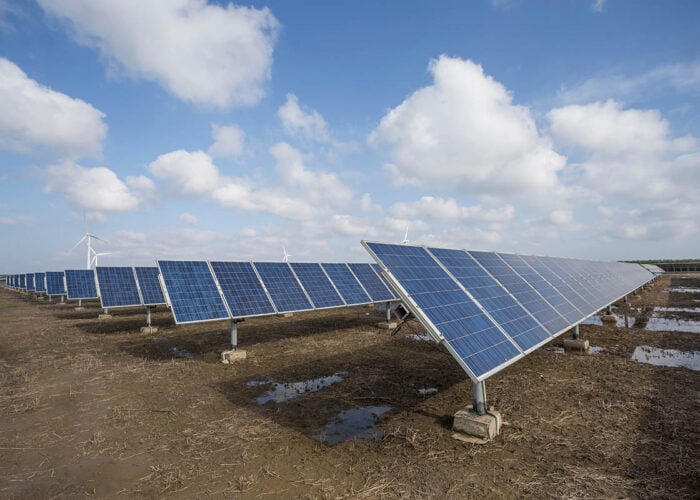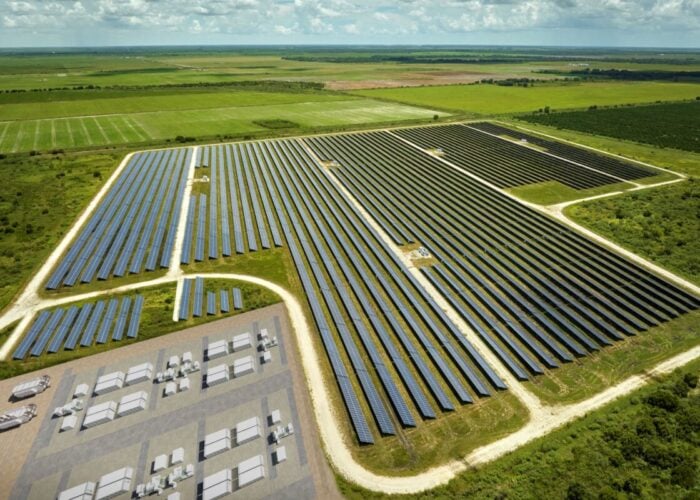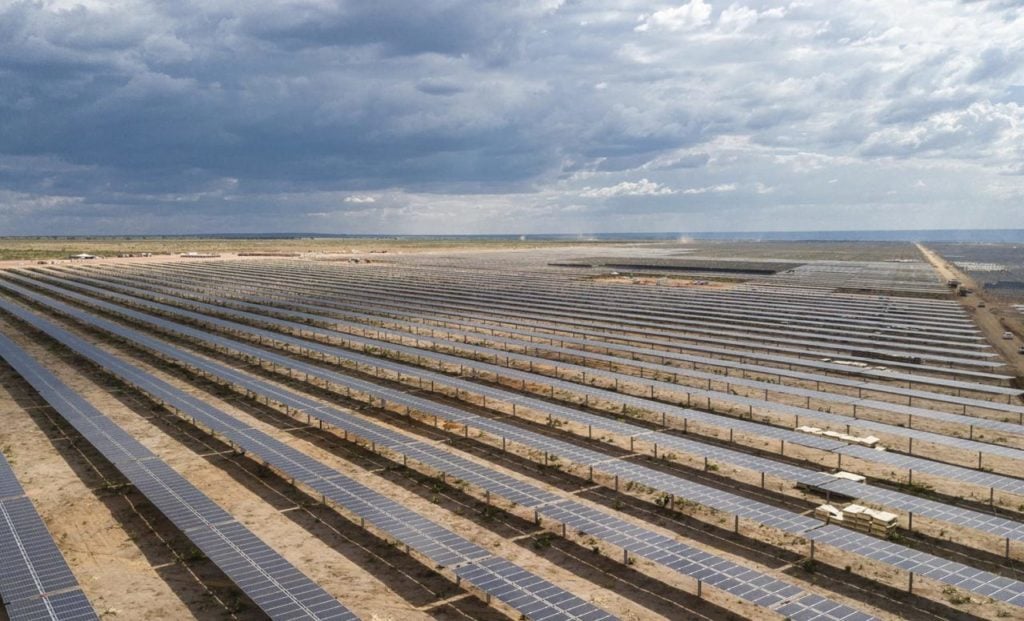
While world leaders were talking the talk in Abu Dhabi, some, at least, of their home countries were backing this up with action. Provisional figures show that 2023 set a new and massive record for utility-scale solar, doubling the previous best.
Large-scale solar installations have increased in almost every year of this century, reaching a record 75GWac of new capacity over 2022. Wiki-Solar’s preliminary data suggest this has leapt to some 150GWac in 2023, taking cumulative operational capacity over 600GWac. If annual installs grow by a mere 7% per annum from here to 2030, this sector will treble, thereby meeting its COP28 target.
Unlock unlimited access for 12 whole months of distinctive global analysis
Photovoltaics International is now included.
- Regular insight and analysis of the industry’s biggest developments
- In-depth interviews with the industry’s leading figures
- Unlimited digital access to the PV Tech Power journal catalogue
- Unlimited digital access to the Photovoltaics International journal catalogue
- Access to more than 1,000 technical papers
- Discounts on Solar Media’s portfolio of events, in-person and virtual
While Europe led the world in the first decade of this century, Asia has been the dominant continent since, spearheaded by China and India. One of the highlights of last year’s results is the way other regions are starting to pull their weight.
North America showed the highest year-on-year growth, of around 150%, compared to about 100% for Asia. South America’s 120% increase makes it a serious contributor, exceeding 6% of global new capacity in 2023.
Americas and Asia take the lead
While the heavy lifting continues to be done by the three top markets – China, the US and India – several other countries are now showing dynamic growth. Spain added 6GWac of new capacity to rocket to an uncontested fourth in the world ranking.
The US leapt back with a vengeance after its installs dipped in 2022, driving growth of 150% in North and Central America. It commissioned over 30GWac of new utility-scale solar capacity, comfortably more than double its previous record. Texas alone contributed over 7.5GWac.
Relatively little support came from other nations in the continent. Canada was once in the top ten, when Ontario was actively promoting renewables, but had fallen to 20th in the world two years ago. New projects, mainly in Alberta, have led to a slight resurgence. Mexico too reached the top ten between 2018-2020 after commissioning several large projects, but is now slipping back down the table.
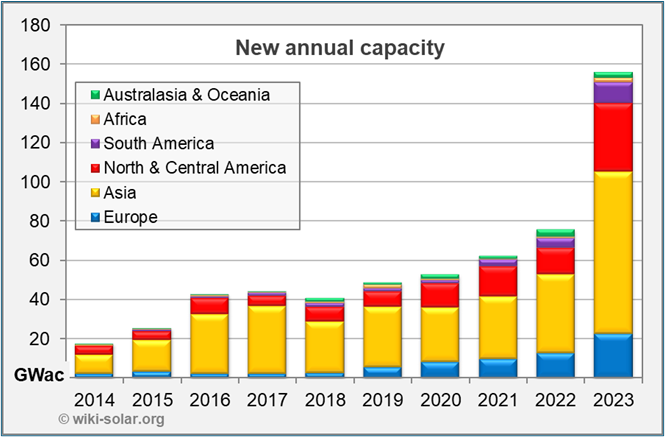
South America saw an increase of 120%, as shown in the graph above, with Brazil installing 5GWac of new capacity – 40% of it cumulative total – in 2023, lifting it into the top 10 and placing it eighth in the world. It still has a pipeline of 20GWac of approved projects in construction and development, so plenty of scope for further growth. Co-leader of South America’s surge, Chile has an even larger pipeline of 40GWac, though it has to date completed only one-third of the 20GWac pipeline it had four years ago.
Asia recorded a 100% increase, and China’s impressive total may yet prove to be understated, if the as-yet-unpublished fourth quarter matches a massive Q3. India too accelerated progress in both its installed capacity and pipeline. These Asian solar superpowers are steadfastly supported by Japan, continuing solid if undramatic progress, though its preliminary figures often prove to be understated.
Vietnamese installs have declined since its 2019 boom, while South Korea and Thailand are also slipping down the table. The Philippines, by contrast, is enjoying something of a resurgence.
Asia’s figures are also bolstered by parts of the Middle East. The UAE has been climbing steadily for some years and Türkiye has been consistently in the top 20. They are joined by Saudi Arabia, which has now climbed into the top 30 for the first time thanks to a handful of mega-projects. But a number of sunny, spacious Middle Eastern nations are notable by their absence.
Spain leads the rest of the world
Europe saw a 75% growth in installed capacity, with Spain the only European country to see a step-change in growth rate, and this should continue at least in the near term thanks to a 10GWac pipeline.
One-time top nation, Germany, has accelerated progress recently, arresting its decline down the table by installing 3-4GWac of new plants last year. The UK too is showing signs of rising from the doldrums, but is still below its 2015 peak. France trundles along looking as if it is trying to stay under the radar.
The Netherlands has recently been one of the continent’s best performers, at least relative to its size, and had another strong year in 2023. Portugal, too, is making good progress. Italy and Greece have been relative underperformers, probably due in part to regulatory difficulties, though both seem to have shown some recent growth. All of these countries are featured on the ranking in the table below.
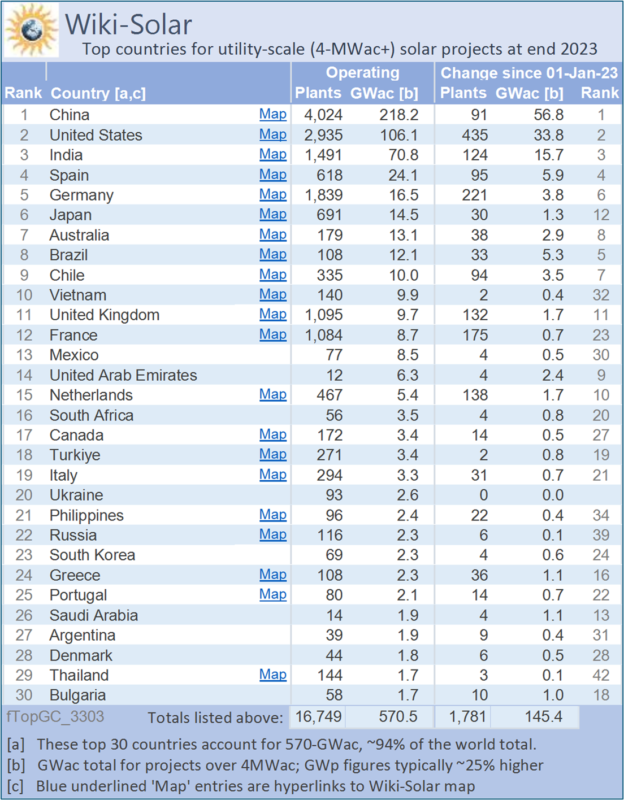
Africa and Australasia, meanwhile, account for less than 4% of the global utility-scale solar market, and aren’t currently threatening to increase that.
A late-starter, Australia began climbing up the table five years ago, but seems to have showed only modest growth last year. However it has a pipeline of some 30GWac, so can be expected to resume an upwards trajectory. New Zealand achieved its first plants recently, but remains a minor league player.
Africa’s only representative in the top 30, South Africa, has disappointed of late, having broken into the top ten back in 2016. However it has a pipeline of some 5GWac, which could help arrest its decline. On the bright side, there are three other African countries in the top 50, led by Egypt, and several other nations on the continent have recently installed their first utility-scale plants.
Prospects for 2024-2030
Utility-scale solar may prove to have been the leading technology for new power generation plant globally in 2023, and there is no reason to believe that this was a flash in the pan. At current cost levels, large-scale PV offers levelised electricity costs lower than any other source in many parts of the world.
The pipeline of projects in construction and development is, as indicated above, extensive. Completions scheduled for 2024 already top the 2023 figure, even with incomplete data for China, so another record year is indicated.
Can this progress continue to 2030? Only a fool makes predictions that far ahead in a volatile and accident-prone world, but, barring accidents, the answer is ’yes’.
2023 has barely ended, and most data sources have yet to publish their year-end results. These figures are therefore subject to a margin of error. Overall and continental totals should prove to be reasonably accurate but more granular national data may be less so, especially as noted herein.
The figures above include both photovoltaics and concentrated solar power. For the purposes of analysis and comparison, ‘utility-scale’ is taken to be plants of 4MWac and over, equivalent to about 5MWp for PV plants.
Wiki-Solar stresses that the figures will change as final data comes in. These provisional capacity numbers include roughly 2,500 new projects, some of which may turn out not to have been commissioned as expected; while other early or unpublicised new plants may have been left out. Historically, however, we have found that these two variances often approximately cancel each other out.
Philip Wolfe operates Wiki-Solar, a database representing over 150GW of capacity of utility-scale projects both operating and under development. He has been active in the solar sector since the mid-1970s, having previously led the organisation that became BP Solar and was a founding member of the group that has since become SolarPower Europe.





